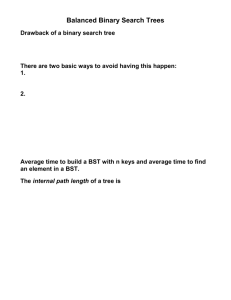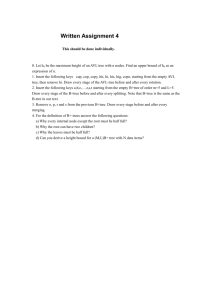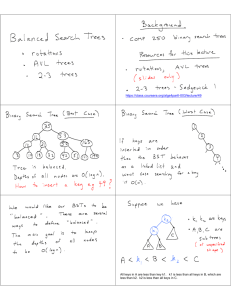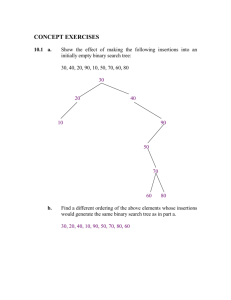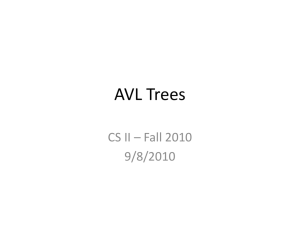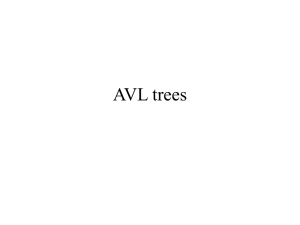avl-tree
advertisement
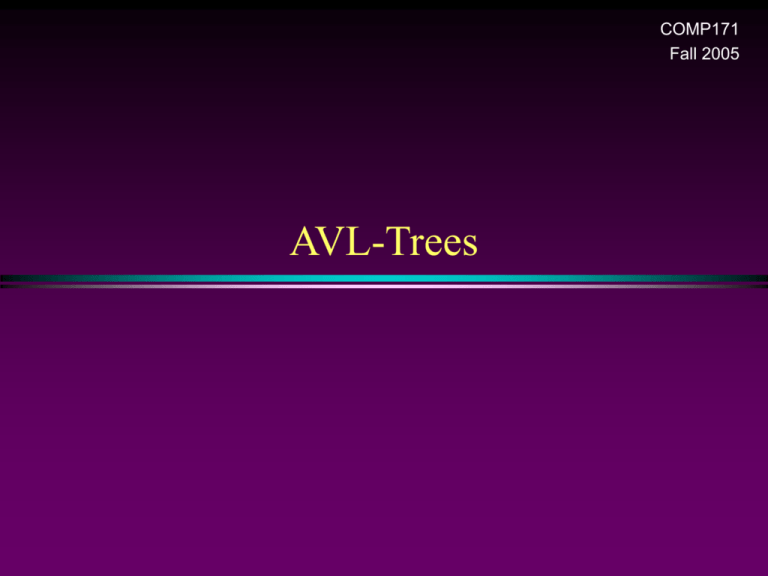
COMP171 Fall 2005 AVL-Trees AVL Trees / Slide 2 Balanced binary tree The disadvantage of a binary search tree is that its height can be as large as N-1 This means that the time needed to perform insertion and deletion and many other operations can be O(N) in the worst case We want a tree with small height A binary tree with N node has height at least (log N) Thus, our goal is to keep the height of a binary search tree O(log N) Such trees are called balanced binary search trees. Examples are AVL tree, red-black tree. AVL Trees / Slide 3 AVL tree Height of a node The height of a leaf is 1. The height of a null pointer is zero. The height of an internal node is the maximum height of its children plus 1 Note that this definition of height is different from the one we defined previously (we defined the height of a leaf as zero previously). AVL Trees / Slide 4 AVL tree An AVL tree is a binary search tree in which for every node in the tree, the height of the left and right subtrees differ by at most 1. AVL property violated here AVL Trees / Slide 5 AVL tree Let x be the root of an AVL tree of height h Let Nh denote the minimum number of nodes in an AVL tree of height h Clearly, Ni ≥ Ni-1 by definition We have N N N 1 h h 1 h2 2 N h2 1 2 N h2 By repeated substitution, we obtain the general form N h 2i N h 2 The boundary conditions are: N1=1 and N2 =2. This implies that h = O(log Nh). Thus, many operations (searching, insertion, deletion) on an AVL tree will take O(log N) time. AVL Trees / Slide 6 Rotations When the tree structure changes (e.g., insertion or deletion), we need to transform the tree to restore the AVL tree property. This is done using single rotations or double rotations. e.g. Single Rotation y x x y C A B B A Before Rotation After Rotation C AVL Trees / Slide 7 Rotations Since an insertion/deletion involves adding/deleting a single node, this can only increase/decrease the height of some subtree by 1 Thus, if the AVL tree property is violated at a node x, it means that the heights of left(x) ad right(x) differ by exactly 2. Rotations will be applied to x to restore the AVL tree property. AVL Trees / Slide 8 Insertion First, insert the new key as a new leaf just as in ordinary binary search tree Then trace the path from the new leaf towards the root. For each node x encountered, check if heights of left(x) and right(x) differ by at most 1. If yes, proceed to parent(x). If not, restructure by doing either a single rotation or a double rotation [next slide]. For insertion, once we perform a rotation at a node x, we won’t need to perform any rotation at any ancestor of x. AVL Trees / Slide 9 Insertion Let x be the node at which left(x) and right(x) differ by more than 1 Assume that the height of x is h+3 There are 4 cases Height of left(x) is h+2 (i.e. height of right(x) is h) of left(left(x)) is h+1 single rotate with left child Height of right(left(x)) is h+1 double rotate with left child Height Height of right(x) is h+2 (i.e. height of left(x) is h) of right(right(x)) is h+1 single rotate with right child Height of left(right(x)) is h+1 double rotate with right child Height Note: Our test conditions for the 4 cases are different from the code shown in the textbook. These conditions allow a uniform treatment between insertion and deletion. AVL Trees / Slide 10 Single rotation The new key is inserted in the subtree A. The AVL-property is violated at x height of left(x) is h+2 height of right(x) is h. AVL Trees / Slide 11 Single rotation The new key is inserted in the subtree C. The AVL-property is violated at x. Single rotation takes O(1) time. Insertion takes O(log N) time. AVL Trees / Slide 12 5 4 1 4 A 0.8 Insert 0.8 3 5 1 4 0.8 8 After rotation 8 y 3 8 3 1 x 5 AVL Tree B C AVL Trees / Slide 13 Double rotation The new key is inserted in the subtree B1 or B2. The AVL-property is violated at x. x-y-z forms a zig-zag shape also called left-right rotate AVL Trees / Slide 14 Double rotation The new key is inserted in the subtree B1 or B2. The AVL-property is violated at x. also called right-left rotate AVL Trees / Slide 15 5 5 AVL Tree y 8 3 A 4 1 C 8 3 4 1 B 3.5 Insert 3.5 4 5 3 1 x 3.5 8 After Rotation z AVL Trees / Slide 16 An Extended Example Insert 3,2,1,4,5,6,7, 16,15,14 Single rotation 3 3 2 3 2 2 Fig 1 1 3 Fig 4 Fig 2 1 2 2 Single rotation Fig 3 1 1 3 3 Fig 5 Fig 6 4 4 5 AVL Trees / Slide 17 2 2 Single rotation 1 1 4 4 3 5 3 5 Fig 8 Fig 7 6 4 2 1 4 Single rotation 2 5 6 3 6 3 1 4 5 Fig 10 Fig 9 2 1 6 7 3 5 Fig 11 7 AVL Trees / Slide 18 4 2 6 7 3 1 16 5 Fig 12 4 Double rotation 2 4 6 2 1 16 5 Fig 13 6 7 3 1 3 5 15 16 15 Fig 14 7 AVL Trees / Slide 19 4 2 1 Double rotation 2 6 3 4 5 15 1 7 3 6 15 16 7 14 5 Fig 15 14 Fig 16 16 AVL Trees / Slide 20 Deletion Delete a node x as in ordinary binary search tree. Note that the last node deleted is a leaf. Then trace the path from the new leaf towards the root. For each node x encountered, check if heights of left(x) and right(x) differ by at most 1. If yes, proceed to parent(x). If not, perform an appropriate rotation at x. There are 4 cases as in the case of insertion. For deletion, after we perform a rotation at x, we may have to perform a rotation at some ancestor of x. Thus, we must continue to trace the path until we reach the root. AVL Trees / Slide 21 Deletion On closer examination: the single rotations for deletion can be divided into 4 cases (instead of 2 cases) Two cases for rotate with left child Two cases for rotate with right child AVL Trees / Slide 22 Single rotations in deletion In both figures, a node is deleted in subtree C, causing the height to drop to h. The height of y is h+2. When the height of subtree A is h+1, the height of B can be h or h+1. Fortunately, the same single rotation can correct both cases. rotate with left child AVL Trees / Slide 23 Single rotations in deletion In both figures, a node is deleted in subtree A, causing the height to drop to h. The height of y is h+2. When the height of subtree C is h+1, the height of B can be h or h+1. A single rotation can correct both cases. rotate with right child AVL Trees / Slide 24 Rotations in deletion There are 4 cases for single rotations, but we do not need to distinguish among them. There are exactly two cases for double rotations (as in the case of insertion) Therefore, we can reuse exactly the same procedure for insertion to determine which rotation to perform
